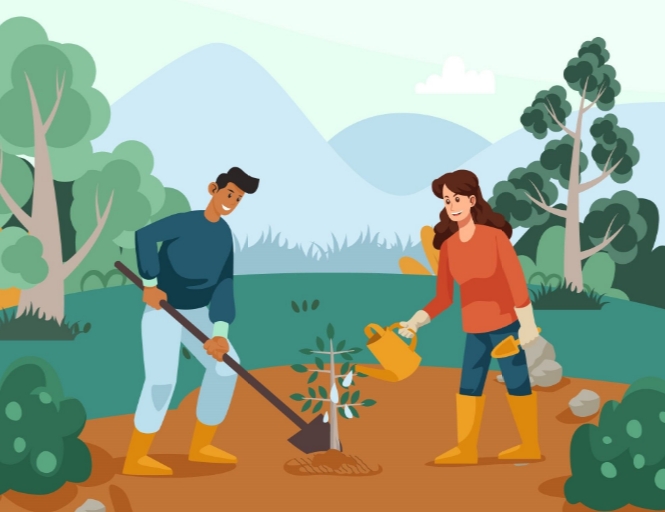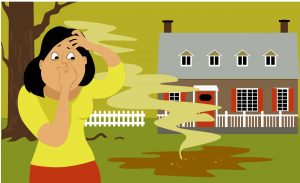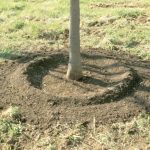
Fall has officially arrived! And with milder weather on its way, it is time to start thinking about your next landscaping project. Fall is one of the best times of year in the Upstate to plant trees. Adding a tree to your property can be a win all around — trees increase curb appeal and property value, provide shade and habitats for wildlife, and improve air quality by storing carbon dioxide while releasing oxygen. However, without proper planning and maintenance, your next landscaping project could be your next plumbing nightmare. Taking a few simple sewer safe landscaping precautions can keep the tranquility of your trees from becoming a catastrophe of your commode.
Plant Life Listens
First, it helps to understand how and why tree landscaping can pose such a problem to your plumbing. The sewer pipes that transport wastewater from your home to larger main sewer lines are called “laterals.” These laterals are typically 4- to 6-inches in diameter and are buried 12- to 30-inches deep. Whatever goes down your drains and into your toilet moves through these lines via gravity, including water and nutrient-rich waste — just think of all that compost, going down the drain! Studies have shown that plant life “listens” for the sound of running water and seeks it out, including water running through pipes. Tree roots, which can spread as much as three times the size of a tree’s canopy, have the strength to break through the pipes and access this goldmine of a water source. While the tree might be happy, you are unlikely to enjoy the plumbing backup this can cause!
Tips and Tricks
Here are six simple sewer safe landscaping tips to avoid costly — and stinky — damage to your lateral sewer lines.
1. Find Your Lines. The first step to creating a landscaping plan is finding out where your sewer lines run underground. You can check your home’s survey documents if you have them, or you can call 811 or visit SC811 online to request a utility locate. This will help you identify all the utility lines that are buried underground,  including your sewer pipes. Be sure to plan ahead — a locate can take up to three full business days to complete.
including your sewer pipes. Be sure to plan ahead — a locate can take up to three full business days to complete.
2. Check for Easements. Your property might include sewer or other utility easements. This is an area of your property that utility technicians need to access to perform inspections, maintenance or repair work. Be sure to keep this area minimally landscaped and clear of debris or structures. You can find utility easements marked on your property deed, or you can contact the county for help locating them.
3. Create Distance. When picking a spot to plant your trees, consider sun and soil needs, but also keep in mind the distance to utilities and easements. Never plant closer to a utility line than 13 feet. The larger and faster growing the tree, the further you need to be. Fast-growing, thirsty trees like willows and cottonwood should be at least 20 to 30 feet away.
4. Choose Wisely. Slow-growing trees with small root systems are your best bet if you are going to plant anywhere near utility lines (but again, give yourself at least 10 feet distance between a tree and a line).  Kwazan cherry trees and Japanese maples are a smart and beautiful choice for the Upstate. Pawpaw trees are also a good choice, with the added benefit of a fruit harvest in August, if the tree is exposed to enough sun. Another fruit-bearing option is the Adams Crabapple tree. While the fruit might not be that tasty, it is a great pollinator for other apple trees, if you happen to have any on your property.
Kwazan cherry trees and Japanese maples are a smart and beautiful choice for the Upstate. Pawpaw trees are also a good choice, with the added benefit of a fruit harvest in August, if the tree is exposed to enough sun. Another fruit-bearing option is the Adams Crabapple tree. While the fruit might not be that tasty, it is a great pollinator for other apple trees, if you happen to have any on your property.
5. Create an Inviting Habitat. Discourage your tree from seeking water and nutrients in the pipes by giving it everything it needs right where it’s planted. Make sure your soil is well-drained and contains adequate nutrients — loamy soils work best. You can have your soil tested to determine exactly what nutrients it needs. If you  have heavy clay soil or it’s strongly compacted, till deeply and add organic materials like compost, building a raised bed of eight- to 12-inches. Once you have the bed established, dig a hole about three times the diameter of the rootball, but no deeper than its height — planting too deep is one of the most common errors, according to Clemson Cooperative Extensions Home and Garden Center. Water the rootball of newly planted trees directly, keeping it
have heavy clay soil or it’s strongly compacted, till deeply and add organic materials like compost, building a raised bed of eight- to 12-inches. Once you have the bed established, dig a hole about three times the diameter of the rootball, but no deeper than its height — planting too deep is one of the most common errors, according to Clemson Cooperative Extensions Home and Garden Center. Water the rootball of newly planted trees directly, keeping it moist but not saturated. Once it is established, water using a raised soil water ring to help concentrate the water and encourage roots to dig deep rather than spread wide.
moist but not saturated. Once it is established, water using a raised soil water ring to help concentrate the water and encourage roots to dig deep rather than spread wide.
6. Enjoy the Fruits of Your Labor! But continue to keep an eye on your plumbing and stay alert for clogs. If you notice slow draining or gurgling sounds, have your pipes checked for blockage. If you are serviced by MetroConnects, call us at (864) 277-4442 before you call a plumber to see if we can help!

Illustrations by freepik